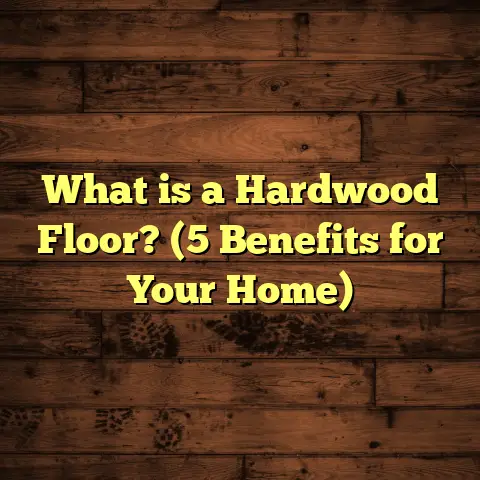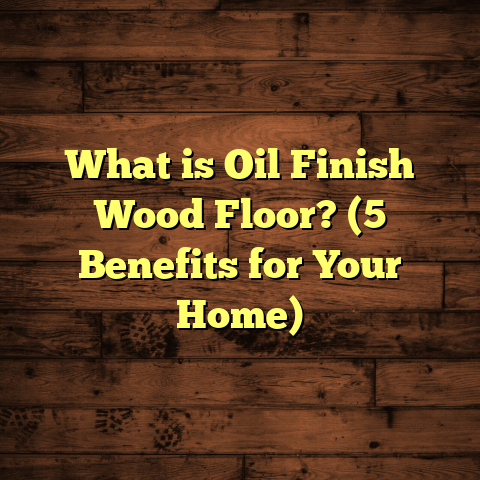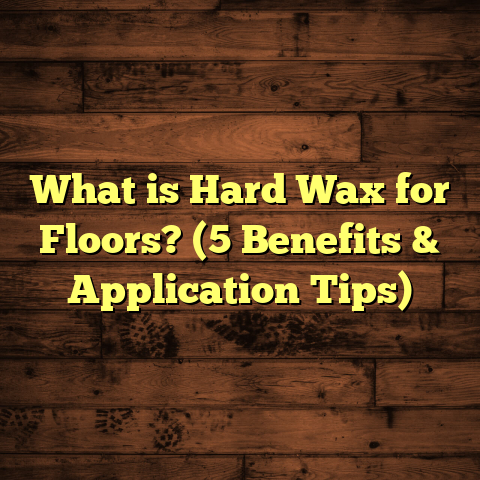What is Fake Wood Floor Called? (5 Types You Need to Know!)
I still remember the day I first stepped into a client’s home to discuss flooring options. The house was beautiful but the floors were worn out, scratched, and stained from years of family life. They wanted the warm, inviting look of wood floors but had a tight budget and a busy household with kids and pets. That’s when I introduced them to fake wood flooring options. Since then, I’ve installed hundreds of these floors and learned a ton about what works, what doesn’t, and what each type really offers beyond just looks. I want to share all that with you so you can make a smart choice for your own space.
What Is Fake Wood Floor?
Fake wood floor refers to any flooring material designed to look like natural hardwood but made from different materials or constructed differently. It’s a broad term that covers products mimicking wood’s grain, color, texture, and overall aesthetic without being pure solid wood planks.
When people ask me, “What exactly counts as fake wood flooring?” I say it includes laminate flooring, vinyl plank flooring, engineered hardwood (which has a thin layer of real wood over a composite core), wood-look tiles made from ceramic or porcelain, and even cork floors printed with wood patterns.
The goal? To offer the beauty and warmth of hardwood floors but with added benefits like easier installation, better moisture resistance, durability against scratches and dents, and often at a more affordable price.
Why Choose Fake Wood Floors?
You might wonder why anyone would go for fake wood floors instead of genuine hardwood. Here’s what I usually tell clients based on my experience:
- Cost Savings: Real hardwood can be pricey—not just the material but also installation and maintenance. Fake wood floors often cost less upfront and save money over time.
- Durability: Many fake wood floors resist scratches, dents, stains, and moisture better than real wood. Great if you have kids or pets.
- Moisture Resistance: Hardwood doesn’t do well in humid areas or places prone to spills, like bathrooms or basements. Fake wood floors like vinyl or tile can handle water much better.
- Ease of Installation: Some fake wood floors come in click-lock planks that you can install yourself without nails or glue.
- Maintenance: Usually simpler cleaning routines with no need for refinishing every few years.
- Variety: Lots of styles, colors, and finishes that can replicate exotic or rare wood species without the cost or environmental impact.
So if you’re looking for something that balances aesthetics, practicality, and budget, fake wood floors are definitely worth considering.
1. Laminate Flooring: The Most Popular Fake Wood Floor
Laminate flooring is often the first thing people think of when they hear “fake wood floor.” It’s a manufactured product made from multiple layers fused together. The core is typically high-density fiberboard (HDF), topped by a photographic layer that replicates wood grain visuals perfectly. Above that is a clear protective wear layer that guards against scratches and stains.
Why Laminate Flooring Is So Common
I’ve installed laminate flooring in hundreds of homes over the years. It’s popular because it hits a sweet spot between affordability, durability, and appearance. You get the look of natural wood without the high cost.
For families with kids and pets, laminate holds up well against scratches and spills—much better than hardwood in many cases. Plus, many laminate products come with warranties ranging from 10 to 30 years depending on quality.
Installation Made Easy
One of the best things about laminate is the installation. Most modern laminate flooring uses a “click-lock” system where planks snap together without glue or nails. This makes it perfect for DIYers or quick professional installs.
When I install laminate, I always recommend using an underlayment beneath it to reduce noise (laminate can sound hollow) and add slight cushioning for comfort.
What You Need to Watch Out For
Laminate flooring is not waterproof. If water seeps into seams or spills aren’t cleaned quickly, the core will swell and ruin the floor. That’s why I don’t suggest it for bathrooms or basements unless it’s specifically rated for moisture resistance.
Also, laminate feels harder underfoot compared to real hardwood because of its rigid core. Some people find it less “warm” or natural feeling.
Real-World Experience
In one project for a family with two dogs and three kids, laminate flooring saved the day. The kids spilled juice constantly but the floor cleaned up easily without stains. And after five years of heavy wear, the floor still looked great thanks to its tough wear layer.
Data Insight
According to industry data from 2023, laminate flooring accounts for about 20% of residential flooring installations in North America—proof of its ongoing popularity.
2. Vinyl Plank Flooring: The Waterproof Wonder
Vinyl plank flooring (often called luxury vinyl plank or LVP) is made from PVC plastic layers with realistic wood grain printed patterns and a tough top wear layer. Unlike laminate, vinyl planks are waterproof.
Why Vinyl Plank Flooring Is a Game-Changer
Whenever someone needs waterproof floors that look like wood—especially in kitchens, bathrooms, basements—I recommend vinyl plank without hesitation.
Over the last decade, vinyl plank technology has improved dramatically. Today’s products feel soft underfoot thanks to thicker wear layers and cushioned backing options. They also come in tons of textures that replicate everything from hand-scraped oak to rustic barnwood.
Installation Flexibility
Vinyl plank can be glued down or installed as a floating floor with click-lock edges similar to laminate. Its flexibility makes fitting around corners or stairs easier than rigid laminate or hardwood.
A couple of times on renovation projects where quick installation was needed before moving in, vinyl plank flooring was a lifesaver because it went down fast and required little curing time.
Downsides to Consider
Cheaper vinyl planks can feel plasticky and look artificial. Also, if you want to refinish floors later on (which is rare for vinyl), you can’t because it’s all synthetic layers.
Vinyl also may emit low levels of VOCs (volatile organic compounds) initially after installation—so choosing low-VOC certified brands is wise for indoor air quality.
Case Study
I helped a family install vinyl plank throughout their basement family room and kitchen. After three years of heavy use—spilled wine parties included—the floor looked almost new. No swelling or warping despite occasional water spills under the sink area.
Market Growth Fact
Vinyl flooring sales have increased by nearly 30% over the past five years across North America due to its waterproof nature and improving aesthetics.
3. Engineered Hardwood: Real Wood Veneer on Composite Core
Engineered hardwood gets tricky because it contains a real wood layer but isn’t solid hardwood all the way through. It consists of thin slices of real hardwood veneer glued over plywood or fiberboard layers underneath.
Why Engineered Hardwood Is Special
Because it uses real wood on top, engineered hardwood has authentic grain patterns and texture that fake wood floors try to imitate.
I often recommend engineered hardwood for spaces where moisture or temperature fluctuations make solid hardwood risky—like basements or kitchens.
It also tends to be more stable dimensionally than solid wood because cross-laminated core layers minimize expansion/contraction.
Refinishing & Longevity
One important thing I always point out: The thickness of the veneer determines how many times you can sand and refinish the floor later. Some veneers are only 1-2 mm thick—good enough for just one light sanding during the life of the floor.
If you want a floor that can be refreshed multiple times over decades, look for engineered hardwood with at least 3-4 mm thick veneer.
Price & Appearance
Engineered hardwood usually costs more than laminate or vinyl but less than solid hardwood—and gives you a natural look many people desire.
I once worked with a client who loved traditional oak floors but had basement remodeling plans. We chose engineered oak hardwood with a thick veneer so she could enjoy real wood aesthetics without worrying about warping from basement humidity.
4. Wood-Look Tile: Durable Porcelain or Ceramic
Wood-look tile is ceramic or porcelain tile printed and textured to look exactly like wood planks including knots and grain patterns.
Why Wood-Look Tile Works Well in Tough Spaces
If you want the look of wood but need extreme durability and water resistance, this is your option.
Bathrooms, mudrooms, kitchens—these spaces benefit from tile’s moisture resistance while still getting that warm visual appeal of hardwood.
I’ve installed wood-look tile in entryways where dozens of muddy shoes cross daily. Tile won’t scratch or fade like wood might under these conditions.
Installation Complexity & Feel
Tile requires professional installation since cutting around walls or fixtures demands skill and special tools.
Tile also feels cold and hard compared to wood floors unless you add radiant heat underneath.
One drawback is slipperiness on polished tile when wet—so selecting textured finishes helps improve safety in wet areas.
Growing Popularity
Wood-look tile sales rose over 15% in recent years as homeowners seek durable yet stylish alternatives for high-moisture rooms.
5. Cork Flooring Printed with Wood Patterns
Cork flooring might surprise you as a fake wood option! But today’s printing techniques let cork feature detailed wood grain visuals while offering unique benefits cork naturally provides.
Why Cork Is Worth Considering
Cork is soft underfoot, warm, sound-absorbing—and eco-friendly since harvested bark regenerates naturally without cutting down trees.
For quiet rooms like bedrooms or nurseries where comfort matters most, cork printed with subtle oak or maple patterns creates cozy spaces that look like hardwood but feel cushioned.
Maintenance & Durability
Cork dents easier than harder surfaces if heavy furniture drags across it often—so use furniture pads!
It also needs sealing during installation—and resealing every few years—to protect against moisture damage.
In one nursery project I handled recently, cork flooring printed with an oak pattern gave charm plus softness perfect for crawling babies and playtime.
Tips From My Experience Installing Fake Wood Floors
Here are some practical tips I’ve picked up over years in the field:
Match Flooring To Your Lifestyle
If you have active kids or pets who scratch floors easily, avoid delicate veneers or soft cork unless you’re prepared for extra care. Vinyl plank or laminate usually works best for durability.
Moisture Matters A Lot
Bathrooms and basements require waterproof options like vinyl plank or tile—not laminate unless specifically rated waterproof (and even then cautiously).
Installation Style Affects Cost & Effort
Click-lock systems make DIY easier; glued-down floors take longer and need pros. Plan accordingly based on budget and skills.
Warranty Is More Than Fine Print
Good products offer wear warranties covering scratches or fading plus moisture warranties—read these carefully before buying.
Don’t Skip Underlayment
Underlayment reduces noise, adds comfort, prevents moisture wicking from below, and extends floor life.
Cleaning & Maintenance Differ
Laminate needs gentle cleaner without excess water; vinyl is very low maintenance; tile grout requires periodic sealing; cork needs resealing every few years too.
Look Closely at Patterns Before Installing
Some printed fake woods have repeating patterns very obvious if not laid thoughtfully—ask your installer about randomized layouts to avoid unnatural repetition.
Data & Research Insights About Fake Wood Flooring Market
According to recent flooring industry reports:
- Vinyl plank sales grew by over 30% between 2018-2023 due to waterproofing advancements.
- Laminate holds steady at roughly 20% market share for residential installations.
- Engineered hardwood represents about 15% of U.S. flooring installs favored for stability.
- Wood-look tile surged 15%+ over five years driven by kitchen/bath demand.
- Cork remains niche (<5%) but interest grows due to sustainability trends.
Consumer surveys indicate durability ranks highest among buyers choosing fake wood floors—more so than appearance alone. Families prioritize stain resistance and ease of cleaning above all else.
When To Choose Which Fake Wood Floor?
To help you decide:
| Flooring Type | Best For | Avoid If |
|---|---|---|
| Laminate | Budget-conscious; moderate traffic; dry areas | Bathrooms; high-moisture zones |
| Vinyl Plank | Kitchens; bathrooms; basements; pets/kids | Wanting natural hardwood feel/refinishing |
| Engineered Hardwood | Stable real wood look; moderate moisture | Tight budget; heavy refinishing needs |
| Wood-Look Tile | Wet areas; heavy wear; allergy concerns | Cold feet; DIY installation |
| Cork (Printed) | Softness & sound absorption; eco-conscious | Heavy furniture dragging; very wet areas |
My Personal Flooring Story: Lessons Learned Over 15 Years
Over my 15 years installing floors professionally, I’ve learned that no single “best” fake wood floor fits every situation perfectly. Success comes down to matching product features with your lifestyle needs and space constraints.
One memorable project was a multi-level condo where we combined three types: engineered hardwood upstairs for warmth, vinyl plank in kitchen/dining for easy cleanup, plus wood-look tile in bathrooms for waterproof durability. The client loved how each area got the perfect balance between beauty and function tailored just right.
Another time I saw laminate installed poorly without proper underlayment resulting in noisy boards that popped after winter cold shrank subfloor gaps. That taught me never to skip small steps that affect long-term satisfaction.
Conclusion: Fake Wood Floors Offer Practical Beauty With Variety
Fake wood floors have come a long way—from early cheap laminates that looked obviously fake to today’s stunning high-tech vinyl planks and engineered woods that rival real hardwood even up close.
Each type brings its own pros and cons depending on where you install it and how much wear it faces daily. Whether you want waterproof resilience, budget-friendly durability, soft comfort underfoot, or authentic grain texture—there’s an option ready for your home.
If you’re thinking about installing fake wood floors but unsure which type fits your lifestyle best or want advice on installation techniques and maintenance—I’m happy to help! Just reach out anytime to chat about your project details so you get results you’ll love living with every day.





